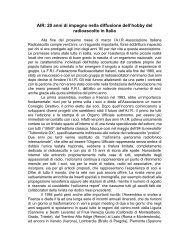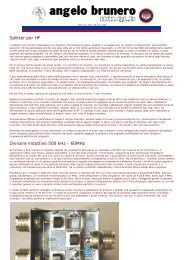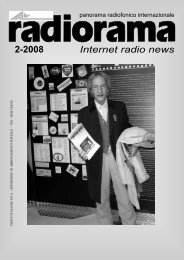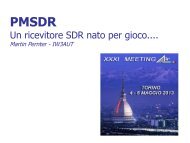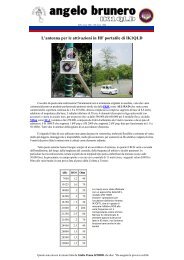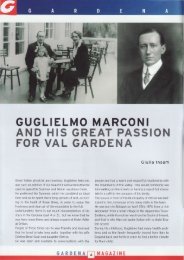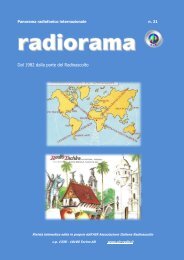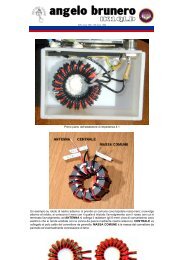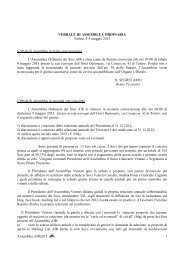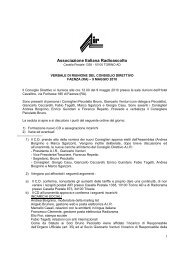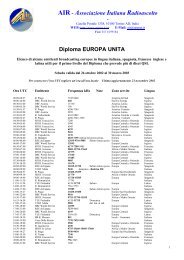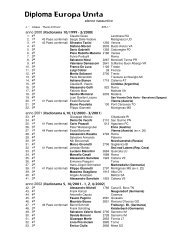Racal RA 1792 technical specifications - AIR
Racal RA 1792 technical specifications - AIR
Racal RA 1792 technical specifications - AIR
Create successful ePaper yourself
Turn your PDF publications into a flip-book with our unique Google optimized e-Paper software.
SWL since 1980 - OM since 1990<br />
<strong>Racal</strong> <strong>RA</strong> <strong>1792</strong> <strong>technical</strong> <strong>specifications</strong><br />
Frequency Range<br />
Modes of Reception<br />
Tuning<br />
Pre-programmed<br />
Channels<br />
Channel Scanning<br />
150 kHz to 30 MHz<br />
USB/LSB (R3E, H3E, J3E, R2A, H2A, J2A)<br />
AM (A3E)<br />
MCW (A2A)<br />
CW (A1A)<br />
ISB (B8E) optional<br />
FM (F3E)<br />
Auxiliary - provides demodulated signal centered on optional fixed BFO offset frequency<br />
Continuously tunable synthesizer in 10 Hz steps over the entire frequency range. Frequency setting<br />
either by numerical keypad or by single tuning knob with continuously variable tuning rate from 1<br />
kHz per turn to approximately 20 kHz per turn, depending on the speed of rotation.<br />
EAROM memory unit may be programmed with up to 100 channel frequencies and mode which may<br />
be recalled by keypad or tuning control.<br />
Automatic scanning of up to ten channels in any decade of the 100 stored channels. Dwell time on<br />
each channel variable in ten steps from 0.1 to 10 seconds; pre-selected by numeric keypad.<br />
Dependent upon frequency standard used:<br />
Frequency Stability<br />
1. The following optional internal standard may be supplied:<br />
a. Temperature Compensated Crystal Oscillator (TCXO): ±2 in 10ºC from -10ºC to<br />
+55ºC.<br />
b. Type 9442:<br />
I. Temperature: ±3 in 10 9 /ºC<br />
II. Long term: ±3 in 10 9 per day after 3 months continuous operations.<br />
2. External standard input: 1 MHz, 5 MHz, or 10 MHz level 0dBm into 50 ohms.<br />
Antenna Input<br />
a. Wideband, 50 ohms to 75 ohms nominal.<br />
b. The receiver will withstand without damage input signals of 50 V EMF continuously.<br />
c. Re-radiation:<br />
I. 0 to 30 MHz: not greater than 10µV PD.<br />
II. 30 to 100 MHz: not greater than 200 pW.<br />
Sensitivity<br />
a. CW and SSB (A1A, R2A, A3E, R3E, J3E): In a 3 kHz bandwidth, signal-plus-noise to noise<br />
ratio is better than: 150 kHz to 1 MHz: 10 dB with 3 µV (EMF) input, 1 MHz to 30 MHz: 10 dB<br />
with 1 µV (EMF) input.<br />
b. AM (A3E): in a 6 kHz bandwidth, signal-to-noise to noise ratio is better than: 150 kHz to 1<br />
MHz: 10 dB with 10 µV (EMF) input, 70% modulated at 1 kHz, 1 MHz to 30 MHz: 10 dB with 3<br />
µV (EMF) input, 70% modulated at 1 kHz.<br />
IF Selectivity<br />
USB<br />
LSB<br />
CW1<br />
CW2<br />
AM1<br />
AM2<br />
AM3<br />
+250 Hz to +3.2 kHz at -6 dB<br />
-400 Hz to -4.3 kHz at -60 dB<br />
+250 Hz to +3.2 kHz at -6 dB<br />
-400 Hz to -4.3 kHz at -60 dB<br />
300 Hz at -6 dB<br />
3 kHz at -60 dB<br />
1 kHz at -6 dB<br />
6 kHz at -60 dB<br />
3.2 kHz at -6 dB<br />
12 kHz at -60 dB<br />
6.0 kHz at -6 dB<br />
20 kHz at -60 dB<br />
16 kHz at -6 dB<br />
50 kHz at -60 dB<br />
Note: a maximum of six filters may be installed, in addition to a 16 kHz bypass.<br />
With a wanted signal of 1 mV EMF in a 3 kHz bandwidth, an unwanted signal 30% modulated
Cross Modulation<br />
removed not less than 20 kHz, must be greater than 500 mV EMF to produce an output 20 dB below<br />
the output produced by the wanted signal.<br />
Reciprocal Mixing<br />
Blocking<br />
Intermodulation<br />
Products<br />
Spurious<br />
Responses<br />
With wanted signal of less than 100µV EMF in a 3 kHz bandwidth, an unwanted signal more than 20<br />
kHz removed is generally greater than 65 dB above the wanted signal level to give a noise level 20<br />
dB below the output produced by the wanted signal.<br />
With a wanted signal of 1 mV EMF, an unwanted signal more than 20 kHz removed must be greater<br />
than 1 V EMF to reduce the output by 3 dB.<br />
In band:<br />
Two 100 mV EMF signals within the IF passband will produce third order intermodulation products not<br />
greater than -50 dB relative to the level of either tone at the IF output.<br />
Out of band:<br />
With two 30 mV EMF signals, separated and removed from the wanted signal by not less than 25<br />
kHz, the third order intermodulation products are not less than 90 dB below either of the interfering<br />
signals.<br />
External (including image and IF rejection):<br />
External signals, removed more than 20 kHz from the wanted frequency, must be greater than +80<br />
dB relative to 1 µV EMF to produce an output equal to that produced by a 1 µV EMF signal at the<br />
wanted frequency.<br />
Internal:<br />
The presence of an internally generated spurious response generally will not degrade the specified<br />
receiver sensitivity by more than 3 dB.<br />
Range:<br />
An increase in input level of 110 dB above 2 µV EMF will produce an output change of less than 2 dB.<br />
AGC<br />
IF Gain Control<br />
BFO<br />
Time constants:<br />
Short, medium and long - preset to be automatically selected by mode switching, but can be set<br />
indipendently by pushin-bottons. AGC lines are available at rear of receiver to permit remote<br />
control.<br />
Control range 110 dB:<br />
Gain control may be switched either to manually set receiver gain or AGC threshold.<br />
a. Variable by main tuning control, ±8 kHz, synthesized in 10 Hz steps<br />
b. Pre-selected fixed offset may be selected for use with external demodulator.<br />
Pre-set Operating<br />
Conditions<br />
1st LO Output<br />
IF Output<br />
Muting<br />
AF Output<br />
Bandwidth, AGC time constant and BFO offset may be preset for each mode so that they are<br />
automatically recalled when the mode is selected.<br />
'Auxiliary' mode may be set up for any mode, bandwidth, AGC constant and BFO offset. In the ISB<br />
mode, diferent AGC time constants may be stored for the two sidebands.<br />
10 dBm ±3 dBm into 50 ohm load, on read panel.<br />
455 kHz, nominal 100 mV into 50 ohms.<br />
60 dB minimum by grounding rear panel connection.<br />
1. Line output, 10 mW maximum into 600 ohms balanced, adjustable by internal preset level<br />
control.<br />
2. Phone output, 1 mW maximum into 600 ohms unbalanced.<br />
3. 200 mW maximum to internal loudspeaker which may be switched in or out of operation.<br />
4. Connection for external loudspeaker, 200 mW into 16 ohms; 400 mW into 8 ohms.<br />
Metering<br />
Front panel display switched to indicate RF level or AF level output to line<br />
All measured supply voltages to be within ±20%<br />
BITE<br />
Power Supply<br />
Power<br />
Consumption<br />
Display<br />
Illumination<br />
Environmental<br />
Conditions<br />
Varactor line voltage: -<br />
20 MHz Reference Loop: 6 to 11 V DC<br />
BFO Synthesizer: 8 V ±0.5 V DC<br />
LO Synthesizer: 3.5 to 15 V<br />
AC: Selections for 110, 120, 220 oer 240 V operation; +10% -15%. 45 to 65 Hz<br />
DC: Receiver may also be operated from an 18 to 32 V DC source when receiver is equipped with<br />
optional DC power supply.<br />
Approximately 60 VA for AC operation; approximately 40 Watts for DC operation.<br />
Presettable.<br />
a. The equipment is designed to operate under the following climatic conditions:<br />
Operating temperature -10ºC to +55ºC<br />
Storage temperature -40ºC to +70ºC<br />
Relative humidity 95% at +40ºC<br />
b. The equipment is suitable for mobile operation.<br />
c. The equipment is suitable for air transportation in unpressurized conditions and for operation<br />
up to altitudes of 3500 metres above the sea level.<br />
Dimensions<br />
Weight<br />
Height - 133 mm (5.29 in)<br />
Width - 483 mm (19 in.)<br />
Depth - 458 mm (18 in.)<br />
14 kg (31 lbs.)<br />
Radio Emission Codes<br />
Radio Emission Codes are specified using three symbols as shown below:<br />
First symbol - Type of modulation of main carrier<br />
Second symbol - Nature of modulating signal<br />
Third symbol - Nature of transmitted signal<br />
The principal symbols are listed below:<br />
First Symbol<br />
Type of Modulation
A<br />
B<br />
C<br />
D<br />
F<br />
G<br />
H<br />
J<br />
K<br />
L<br />
M<br />
N<br />
P<br />
R<br />
Second Symbol<br />
0<br />
1<br />
2<br />
3<br />
7<br />
8<br />
Third Symbol<br />
A<br />
B<br />
C<br />
D<br />
E<br />
Double sideband, AM<br />
Indipendent sideband, AM<br />
Vestigial sideband, AM<br />
Amplitude/Angle modulation<br />
Frequency modulation<br />
Phase modulation<br />
Single sideband full carrier<br />
Single sideband suppressed carrier<br />
Pulses, amplitude modulated<br />
Pulses, width or duration modulated<br />
Pulses, phase or position modulated<br />
Unmodulated carrier<br />
Pulses, unmodulated<br />
Single side band reduced or variable carrier<br />
Nature of Modulating Signal<br />
No modulation signal<br />
On/Off modulation (keyed CW)<br />
Modulation sub carrier (keyed MCW)<br />
Analogue modulation (voice)<br />
Two or more channels on one frequency offering keyed telegraphy<br />
Two or more channels on one frequency offering telephony (voice)<br />
Type of Information Being Transmitted<br />
Telegraphy for aural reception<br />
Telegraphy for automatic reception<br />
Facsimile<br />
Telemetry<br />
Telephony<br />
All data from the original Maintenance Manual of HF Receiver <strong>RA</strong> <strong>1792</strong> (83000, 82129 and 85830) edited by<br />
<strong>Racal</strong> Communications Limited, Western Road, Bracknell, RG121RG england, Ref TH 3416.<br />
Home > IK1QLD > <strong>Racal</strong> <strong>RA</strong>-<strong>1792</strong> > Technical Specification<br />
© Angelo Brunero, 2003/2006 - Informativa legale




